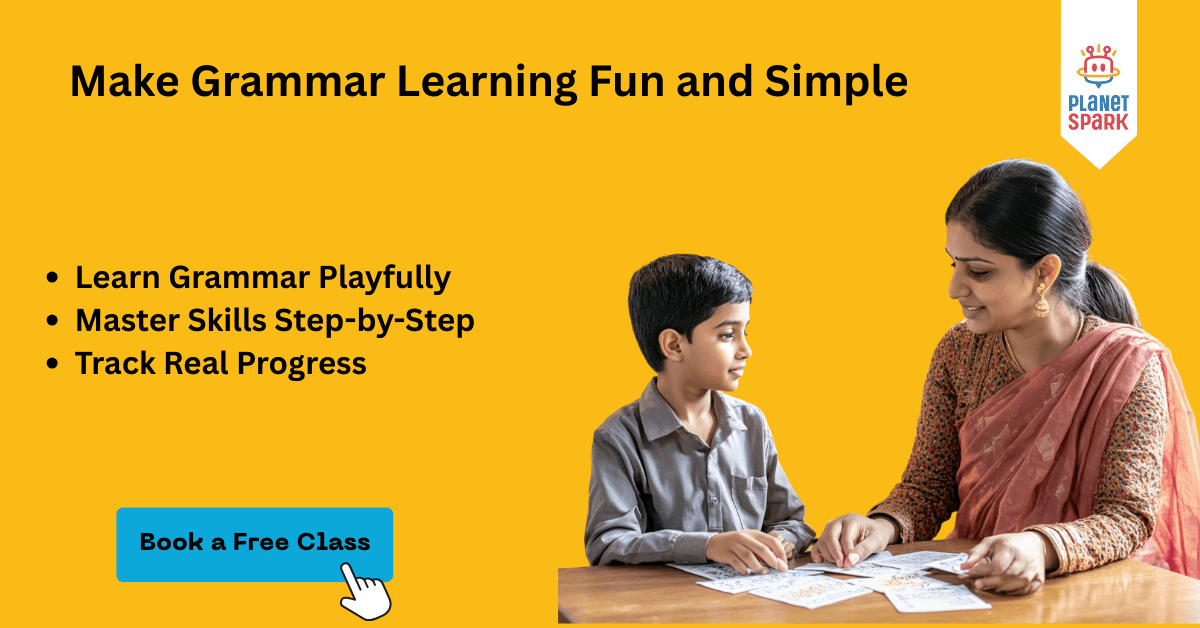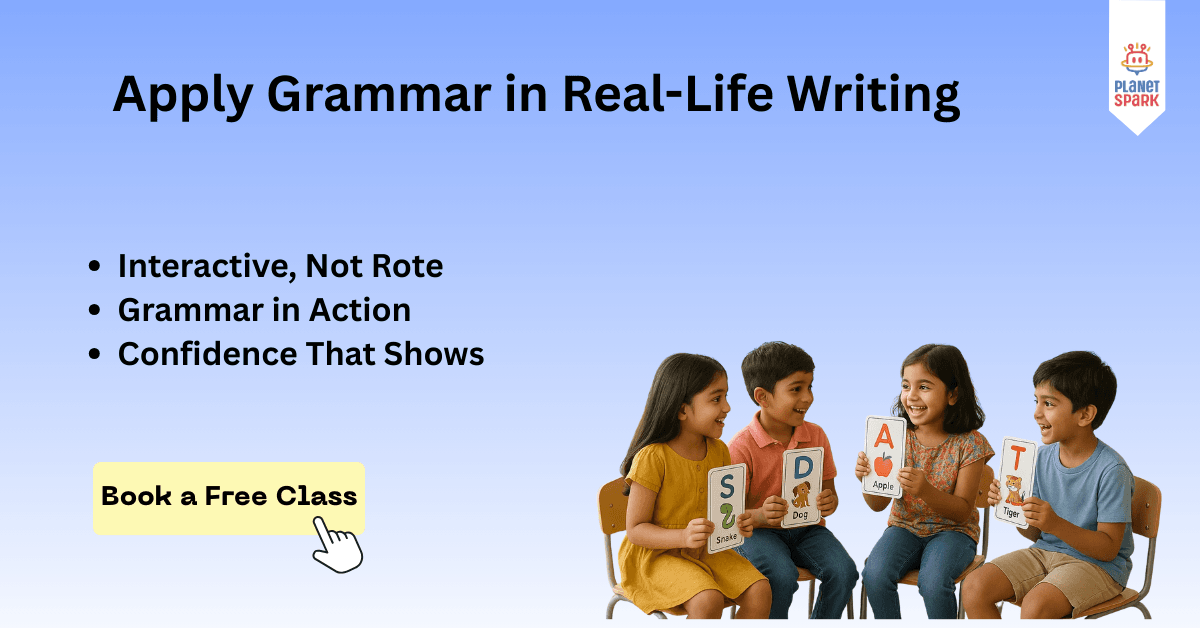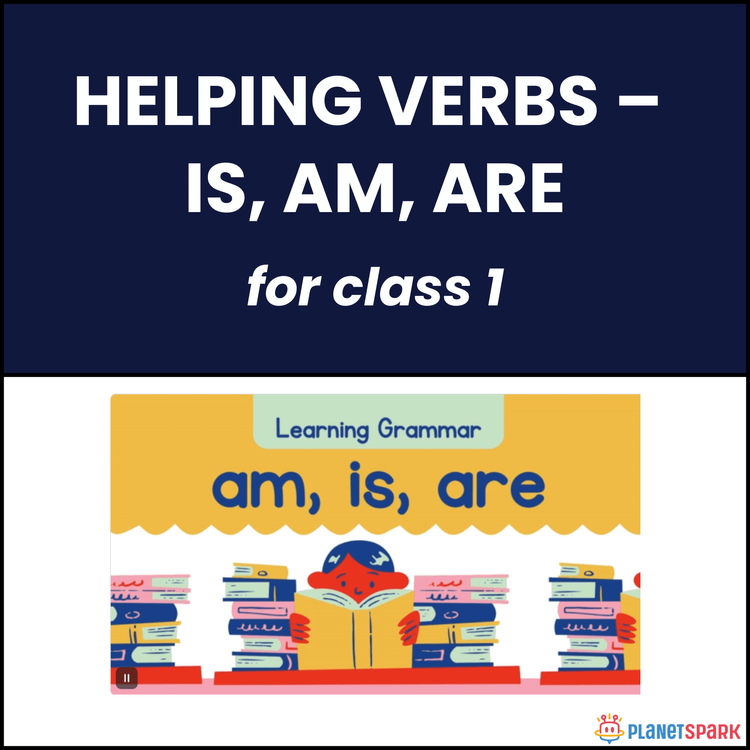Helping Verb: Definition, List, Chart, and Examples in English

Table of Contents
- What is a Helping Verb?
- Helping Verbs List in English
- Types of Helping Verbs
- Helping Verb Definition
- Helping Verb Chart (Tense-wise)
- Helping Verb Examples
- Helping Verb Sentences
- Difference Between Main Verb and Helping Verb
- Common Mistakes with Helping Verbs
- Helping Verbs Worksheet (Practice Exercises)
- Why are Helping Verbs Important?
- Advanced Notes on Helping Verbs
- Helping Verbs in English Grammar Learning
- PlanetSpark English Grammar Course
- Frequently Asked Questions (FAQs)
English grammar is like the framework of a building, and verbs act as the foundation that holds it together. While main verbs show the central action or state, helping verbs (also called auxiliary verbs) work alongside them to give sentences accuracy, clarity, and depth.
Imagine saying:
“She running fast.”
This sentence is incomplete and incorrect. Add a helping verb, and suddenly it becomes:
“She is running fast.”
That tiny word “is” completely changes the meaning, makes the grammar correct, and communicates the intended action.
In this detailed guide, we’ll explore what a helping verb is, study the helping verbs list, examine a tense helping verb chart, and go through definitions, examples, and worksheets. You’ll not only learn the rules but also understand how to apply them in daily communication.

What is a Helping Verb?
A helping verb is a verb that accompanies the main verb to form a verb phrase. It adds detail about the time (tense), possibility, necessity, or voice of the action. Without it, many English sentences would either sound unnatural or be grammatically wrong.
Examples:
They are going to the park.
She has finished her homework.
I will attend the meeting.
Notice that “are,” “has,” and “will” are not showing the main action but are helping the main verb.
Key points to remember:
Helping verbs cannot stand alone; they always need a main verb.
They clarify whether something is happening now, happened before, or will happen later.
They also help form questions and negatives.
Helping Verbs List in English
English has a limited set of helping verbs, but they are used very frequently. Memorizing the helping verbs list helps learners spot them easily in sentences.
Primary Helping Verbs:
Be (am, is, are, was, were, be, being, been)
Have (have, has, had)
Do (do, does, did)
Modal Helping Verbs:
Can, Could
May, Might
Must
Shall, Should
Will, Would
👉 Together, these 23 words are used in countless sentence structures
Types of Helping Verbs
Helping verbs in English can be classified into two main categories:
1. Primary Helping Verbs
These are the most basic auxiliaries: be, do, and have.
Be: Used in continuous tenses and passive voice.
She is writing a letter.
The work was completed on time.
Have: Used in perfect tenses.
I have seen that movie.
They had left before you arrived.
Do: Used for questions, negatives, and emphasis.
Do you like pizza?
She does not agree.
I do want to help you.
Unlock your child’s full language potential with our expert mentors.
2. Modal Helping Verbs
Modals express ability, permission, obligation, or possibility.
Can: He can swim fast.
Might: She might come tomorrow.
Should: You should study harder.
Must: We must respect our elders.
These words are essential for expressing nuances in English.
Helping Verb Definition
The simplest definition of a helping verb is:
A helping verb is a word that helps the main verb show tense, voice, or mood.
Unlike main verbs, helping verbs do not show action by themselves. Instead, they add precision to the action of the main verb.
Helping Verb Chart (Tense-wise)
A tense helping verb chart shows how auxiliaries work in different situations:
| Tense/Aspect | Helping Verb(s) | Example Sentence |
|---|---|---|
| Present Continuous | am, is, are | She is reading a book. |
| Past Continuous | was, were | They were playing cricket. |
| Future Continuous | will be | He will be working late. |
| Present Perfect | have, has | I have eaten lunch. |
| Past Perfect | had | She had left early. |
| Future Perfect | will have | They will have finished. |
| Passive Voice | be, been, being | The task is done. |
👉 This helping verb chart is a quick reference for students learning English grammar.
Helping Verb Examples
Here are more helping verb examples in different contexts:
She is dancing gracefully.
They were studying all night.
He has gone to the market.
I will attend the class.
You must finish your homework.
We can play outside today.
Notice how each sentence sounds incomplete without the helping verb.
Helping Verb Sentences
Let’s practice with sentences using helping verbs:
She is cooking pasta for dinner.
He has written three books.
They will join the competition.
You should listen carefully.
We were laughing together.
By adding a helping verb, each sentence gains clarity and accuracy.

Difference Between Main Verb and Helping Verb
Students often confuse these two. Here’s a simple comparison:
| Feature | Main Verb | Helping Verb |
|---|---|---|
| Meaning | Expresses main action | Supports the main verb |
| Example | She writes stories. | She is writing. |
| Independent? | Can stand alone | Cannot stand alone |
👉 Helping verbs depend on main verbs, while main verbs can exist alone.
Common Mistakes with Helping Verbs
Learners frequently make errors while using helping verbs. Let’s see some:
Omitting the helping verb in continuous tense.
❌ She running fast.
✅ She is running fast.
Wrong agreement with subject.
❌ He have gone.
✅ He has gone.
Unnecessary use of two modals together.
❌ She can might come.
✅ She might come.
Confusing main verb with auxiliary use.
❌ I am agree.
✅ I agree.
Helping Verbs Worksheet (Practice Exercises)
Try these exercises to test your knowledge:
A. Fill in the blanks:
They ___ playing cricket.
She ___ finished her assignment.
You ___ not worry about it.
He ___ be late today.
I ___ never been to London.
Answers: 1. are, 2. has, 3. should, 4. may/will, 5. have
B. Identify the helping verb:
She is working hard.
They have gone home.
He must finish his work.
👉 Practicing with worksheets improves accuracy.
Why are Helping Verbs Important?
Helping verbs are more than just small grammar words. They:
Show time of action (past, present, future).
Help form negative sentences.
Make questions possible.
Express possibility or obligation.
Allow sentences to be written in the passive voice.
Without them, English would lose flexibility and precision.
Advanced Notes on Helping Verbs
Be, Do, Have as both main and helping verbs:
Main Verb: I have a car.
Helping Verb: I have eaten lunch.
Contractions in spoken English:
I am → I’m
She will → She’ll
They have → They’ve
Multiple helping verbs together:
She will have finished the work.
👉 These advanced rules help learners sound natural and fluent.
Helping Verbs in English Grammar Learning
For students, helping verbs are a stepping stone to mastering English. Once you understand them, you can easily learn tenses, questions, modals, and passive voice.
Practical activities like games, worksheets, role plays, and storytelling make grammar fun and interactive.
Helping verbs may be small, but they have big importance in grammar. From forming tenses to expressing moods and questions, they are at the heart of English communication.
By studying the helping verbs list, chart, examples, and worksheets, learners can build confidence in speaking and writing.
If you want to go beyond self-study, join PlanetSpark’s English Grammar Course, where grammar becomes simple, fun, and effective.

PlanetSpark English Grammar Course
Strong grammar skills form the backbone of effective communication. Yet, for many children, grammar often feels boring, confusing, or too technical. That is where PlanetSpark’s English Grammar Course comes in. The program is designed to make grammar simple, interactive, and fun, so that kids not only understand the rules but also learn to apply them confidently in speaking and writing.
Instead of rote memorization, PlanetSpark focuses on experiential learning through activities, stories, and real-life examples. Kids engage with grammar in ways that feel natural, making it easier for them to retain concepts and use them effectively.
Why Choose PlanetSpark’s Grammar Course?
Interactive Story-Based Learning
Children learn grammar through engaging stories and real-life scenarios rather than dull lectures. For example, a story about superheroes may be used to explain helping verbs or tenses.Activity-Driven Approach
Worksheets, quizzes, games, and role-play sessions keep learners active and curious. Kids practice grammar concepts in different formats, which makes learning stick.Personalized Feedback from Experts
Every child is unique, and so is their learning style. PlanetSpark mentors provide individual attention, helping kids identify their weak areas and guiding them with tailored strategies for improvement.Step-by-Step Grammar Mastery
The course covers grammar systematically, from basics like nouns, verbs, and helping verbs to advanced concepts like sentence structure, prepositions, and tenses. Each topic is built on the previous one, ensuring a strong foundation.Confidence in Communication
Beyond worksheets, the course emphasizes practical application. Children use grammar in speaking, debates, and creative writing exercises, which builds fluency and confidence in real-world communication.Fun and Engaging Environment
With a mix of interactive tools, games, and visual aids, grammar becomes something children look forward to learning. The idea is simple, when kids enjoy learning, they learn better and faster.
Key Benefits at a Glance:
Learn grammar without fear or boredom.
Understand concepts through stories and examples.
Apply grammar in speaking, writing, and daily conversations.
Grow confidence with consistent mentor support.
Build a solid language foundation for academic and personal success.
👉 With PlanetSpark, grammar is not just about rules, it’s about helping children communicate effectively and confidently in every situation.
Frequently Asked Questions (FAQs)
Q1. What is a helping verb in English?
A helping verb is a verb that supports the main verb to show tense, mood, or voice.
Q2. Can a sentence have more than one helping verb?
Yes. Example: She will have completed the project.
Q3. What is the difference between main verb and helping verb?
Main verbs show the action, helping verbs support them.
Q4. How many helping verbs are there in English?
There are 23 commonly used helping verbs (primary + modals).
Q5. Why are helping verbs important?
They make it possible to express tense, negatives, questions, and passive voice.
Q6. Can "do" be used as both a main verb and a helping verb?
Yes. As a main verb, it expresses an action (e.g., I do my homework). As a helping verb, it is used for questions, negatives, or emphasis (e.g., Do you like apples?).
Q7. What are some examples of sentences with two helping verbs?
Examples:
She will have completed her project by tomorrow.
They might have been waiting for hours.
In these sentences, two or more helping verbs work together with the main verb.
Q8. Are modal verbs the same as helping verbs?
Modal verbs are a type of helping verb, but they serve a special role by showing ability, permission, possibility, or necessity (e.g., can, must, should).
Q9. How do helping verbs change in questions?
In questions, helping verbs often move to the beginning of the sentence.
Statement: She is reading a book.
Question: Is she reading a book?
Download Free Worksheets
Personalized Communication Report
Record a video to get a AI generated personalized communication report for your child

Hi There, want to try these
tips for your child with
LIVE with our expert coach?
Let's check your child's
English fluency

